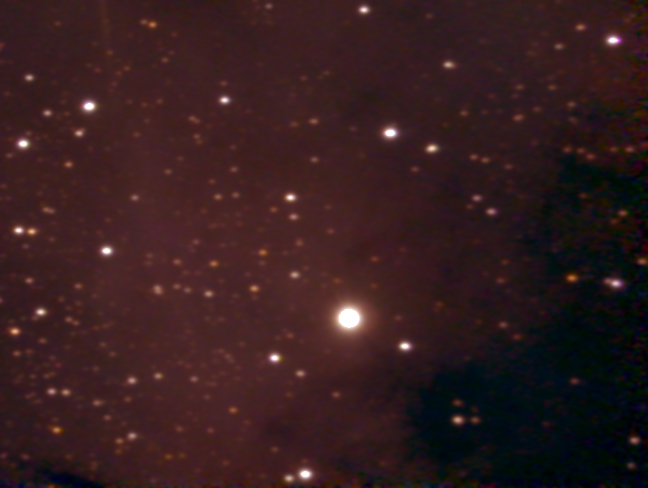
NGC7000: N. American Nebula

RA: 20hr 58min 48s Dec: 44º 20' 00" Mag: 6.0 Distance: 3000 Light Years Constellation: Cygnus
Before you say, "Hey, that doesn't look like the N. American Nebula!" allow me to explain - the N. American nebula is HUGE. It fills the visual field of my 15x60 binoculars, so even at f3.3, I was only able to get a mere fraction of it within the field of the DSI. (Addendum 16/8/07 - I have since managed to photograph the entire nebula and you can see it in the widefield section of this website or by clicking here.) So which bit have I got above? If you imagine the shape of continental N. America, the part you see above is Texas, New Mexico and the Gulf of Mexico. For those of you who can imagine this: (I can't) the whole of the N. American nebula subtends a whopping 120 arc minutes x 100 minutes, so it really needs binoculars to see! This picture was taken in the small hours of the 24th of July, the moon was new and the sky was as clear as it ever gets in Summer in Sunningwell. T=16.7°C. This picture above was just the product of one series of exposures by Envisage - no subsequent stacking. 84, 30 second exposures were made, for a cumulative exposure time of 42 minutes. The bright star in the centre is SAO 50313.
This picture was very difficult to take from the point of view of locating the area of nebulosity - it has very low intrinsic luminosity. Over 3 nights, I searched between ξ Cygni and Deneb, around the area of an arrow-head asterism with SAO 50298 at the apex. I made 3 attempts at processing this picture where the nebulosity was faint compared with the noise in the background and careful midtone enhancement had to be carried out without 'digitising' the edges too much. The picture chosen was the 2nd attempt - adjustment of black levels to reduce the 'noise' in the darker patches of sky, then a layer mask applied in negative with a slight Gaussian blur to prevent star 'bloating' during midtone enhancement - and finally the midtone enhancement itself carried out in the individual RGB channels using the curves command. Final adjustment was with the combined RGB levels command to preserve the black of space in the bottom right hand corner. For the first time, the flare from SAO 50313 is NOT rendered. It is genuinely in the picture.
HOME PICTURES: Deep Sky PICTURES: Solar system PICTURES: Wide field